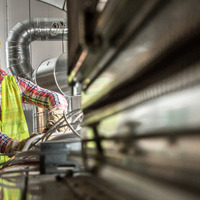By Jack French, CEM, CMVP, senior manager of Energy Analytics at GridPoint, and Scott Stewart, CEM, CMVP, senior energy data analyst at GridPoint — As the vibrant colors of autumn foliage signal the arrival of fall and soon winter, facility managers (FMs) find themselves facing a unique set of challenges and opportunities to enhance energy efficiency within their buildings. The shift in seasons brings fluctuating temperatures, shorter daylight hours and distinct operational needs that demand a fresh perspective on managing energy consumption.
To navigate this transitional period effectively, facilities managers must embrace innovative strategies and implement practical solutions. Here are seven energy efficiency tips tailored for the winter months to help FMs cut operational costs while contributing to greener processes and greater sustainability overall.
Optimize HVAC systems
Heating, ventilation and air-conditioning (HVAC) systems are often the largest energy consumers in a facility. Regular maintenance is the cornerstone of HVAC efficiency enhancement. This includes cleaning and replacing filters, checking outdoor damper positions, and clearing leaves and debris from outdoor equipment. These routine tasks significantly improve overall system efficiency, reduce repair and replacement costs, and extend the system’s lifespan.
In addition to maintenance, consider implementing temperature setbacks and using programmable thermostats. These measures allow you to reduce heating and cooling during off-hours or when spaces are unoccupied. This simple yet effective approach aligns HVAC operations with actual occupancy and usage patterns, resulting in substantial energy savings.
Check for leaks in windows and doors
Examine the seams of windows and exterior doors for possible air leaks. A simple hand test can do the trick. If you feel cold air or notice daylight seeping through gaps around the frames, it’s an indication of an air leak. Once you’ve located a leak, apply caulking, sealing or weather stripping to seal these openings. This prevents heat loss and ensures a more comfortable interior environment.
Inspect insulation
Insufficient insulation may lead to temperature disparities, causing thermostats to register lower temperatures than the actual conditions within the interior space. This misjudgment can inadvertently lead to overheating within the zone, needlessly consuming energy. Ensuring proper insulation is in place is essential for maintaining consistent temperatures and minimizing energy waste.
Verify thermostat or zone sensor placement
Avoid placing thermostats or zone sensors near appliances that generates heat to maintain accurate temperature regulation. Any source of warm or cool air near the thermostat can cause the unit to over- or under-condition the space, leading to excess unit runtime. You can use a handheld thermometer to compare readings near the thermostat and at the center of the room to confirm proper placement.
Switch to energy-efficient lighting
It’s essential to replace traditional lighting with LEDs wherever feasible, as they consume significantly less electricity and have longer lifespans. Implement a lighting schedule that aligns with natural daylight patterns, and adjust the schedule based on variations in sunrise and sunset times. This ensures that lighting is used efficiently.
Start a preventive maintenance schedule
Proactive HVAC maintenance is paramount for efficient and uninterrupted heating and cooling. Setting up a preventive maintenance schedule helps avoid unexpected system failures, especially during extreme weather conditions. Regular inspections and servicing allow for earlier detection and resolution of potential issues, ensuring that your HVAC system operates reliably when you need it most.
Educate your employees
Effective energy management within a business starts with employee engagement and awareness. Educate employees about why the energy management program is essential for your business, emphasizing its impact on sustainability and overall environmental responsibility. Make sure they understand their roles and whom to contact if there is an issue. Employee engagement can greatly enhance the success of your energy efficiency initiatives and foster a culture of sustainability within your organization.
As facility managers prepare for the winter season, they must be proactive in optimizing energy efficiency. By implementing these strategies, from HVAC system maintenance to insulation inspection, lighting upgrades and employee education, facility managers can significantly reduce operational costs and contribute to a more sustainable and environmentally responsible future.
About the Authors
 Jack French, CEM, CMVP, is a senior manager of energy analytics at GridPoint, a leader in building energy management and optimization technology that decarbonizes commercial buildings and drives grid modernization.
Jack French, CEM, CMVP, is a senior manager of energy analytics at GridPoint, a leader in building energy management and optimization technology that decarbonizes commercial buildings and drives grid modernization.
 Scott Stewart, CEM, CMVP, is a senior energy data analyst at GridPoint.
Scott Stewart, CEM, CMVP, is a senior energy data analyst at GridPoint.






